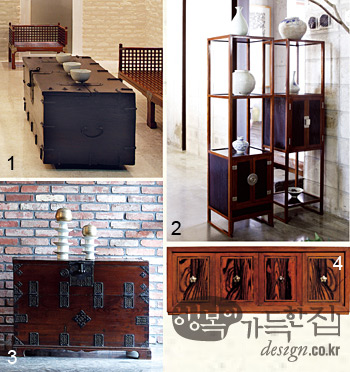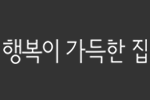 흔히 말하는 전통 목가구는 조선시대로부터 비롯된 것이 대부분이다. 조선시대에는 유교 사상에 입각하여 남성(남편)의 공간인 사랑방과 여성(아내)의 공간인 안방의 구분이 있었고, 이에 따라 가구의 기능이나 모양이 구분되었다. 조선시대 목가구로 오늘날까지도 많은 인기를 얻고 있는 것으로 다음의 네 가지를 꼽을 수 있다. 사방탁자는 대표적인 사랑방 가구로 ‘서가 書架’를 의미한다.
흔히 말하는 전통 목가구는 조선시대로부터 비롯된 것이 대부분이다. 조선시대에는 유교 사상에 입각하여 남성(남편)의 공간인 사랑방과 여성(아내)의 공간인 안방의 구분이 있었고, 이에 따라 가구의 기능이나 모양이 구분되었다. 조선시대 목가구로 오늘날까지도 많은 인기를 얻고 있는 것으로 다음의 네 가지를 꼽을 수 있다. 사방탁자는 대표적인 사랑방 가구로 ‘서가 書架’를 의미한다. 사방이 개방된 직선형 가구로 책과 문서, 문방구를 수납할 수 있도록 만든 것. 이는 안방에서도 사용했는데 장식용으로 쓰기도 했다. 문갑도 사랑방과 안방에서 모두 사용했으며, 한국의 좌식 생활을 보여주는 대표적인 가구이다. 책과 문방구를 수납하기도 했으며 안방의 문갑은 자개 등을 이용해 장식성을 부각시켰다.
반닫이는 나무로 된 상자인 ‘궤’의 한 종류로 문이 앞으로 반만 열리는 가구이다. 어느 집이든 필수적으로 가지고 있었던 가구로 중요한 물건을 보관하거나 살림을 정리하는 등 다양한 수납 기능을 갖췄다. 궤는 나무로 된 상자를 말하며 상자의 상판을 반으로 나눠 한쪽을 문으로 여닫게 한 가구이다. 돈, 책, 문서, 의복, 건어물, 제기 등을 보관하는 용도로 사용했다. 지역에 따라 형태가 다른데, 북쪽 지방으로 갈수록 높이가 높아지며, 남쪽으로 갈수록 가로로 길고 낮은 형태를 띤다.
The Korean Joseon upper-class society traditionally followed the Confucian priciple. The Confucian principle of separation of the sexes was reflected in Joseon furniture as well, so the furniture of the sarangbang(master’s room) was mainly related to painting and calligraphy. The furniture and implements used by master, who considered the composition and study of literature to be very important, were diverse and well developed. … Because the furniture for the anbang was made to be used in a secluded space rather than an open one like the sarangbang, it varied very little in form and mostly consisted of storage chests, women’s articles, and decorative pieces. Compared to furniture used in the men’s rooms, women’s furniture was richly decorated.
1 궤(또는 함) Gwe or Ham(boxes): Boxes were classified as either ham or gwe depending on whether or not they were hinged. The ham was a box with a fitted lid that constituted the whole top of the box, and therefore had no hinges. The gwe was a box with a wholly or partially hinged lid. In the mistress’s room, various lidded boxes included the box for wedding gifts, jewelry box, and box for headgear, while hinged boxes included the money box, thread box and box for hairpieces. Women’s boxes were mostly lacquered and inlaid with mother-of-pearl, and they were kept on top of chest.
2 사방탁자 Sabangtakja(book and display stand ): This piece of furniture consisted of wooden posts and boards to make up several tiers of square open shelves, sometimes with a chest occupying one tier. Because of its simplicity it was elegant and suitable even for a small space. Like the mungap, it was used to store books and documents and to display a variety of ornamental items.
3 반닫이 Bandaji(clothing chest): This chest was about 70~80 cm tall, and was decorated on the front with metal ornaments and hinges. The hinged front flap that constitutes the top half opens downwards. It was used to store clothes or important documents and was made of strong wood, such as pagoda wood, with a nicely patterned wood grain. The styles differed slightly according to region and were named accordingly, for example Gyeonggi bandaji, Jeonju bandaji. The clothing chest from Pyongyang, North Korea, was called Bakcheon bandaji. It was taller than usual and heavily decorated.
4 문갑 Mungap(stationary chest ): The mungap, used for storing books and documents, was just the right height for the Korean lifestyle of sitting on the floor. It was an indispensable piece of furniture in both the master’s room and the mistress’s room. With a width that exuded a sense of stability, the top of the chest was used to place brush holders, paper containers, water droppers, and ornamental rocks for handy access and also for decorative effect. Mungap were used alone or in pairs. When a single chest was used it was a little higher than those used in pairs.
* 위의 용어 설명은 이화여자대학교 출판부에서 발행하는 ‘The Spirit of Korean Cultural Roots’ 시리즈 중 제19권







